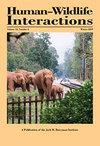Interactions Between Humans, Crocodiles, and Hippos at Lake Kariba, Zimbabwe
IF 0.9
4区 环境科学与生态学
Q4 BIODIVERSITY CONSERVATION
引用次数: 9
Abstract
Human–wildlife conflicts (HWCs) are on the increase due to shrinking space that results in increased competition for land, water, and other natural resources between humans and wildlife. Investigating the occurrence of HWCs is important in that the results can be used to formulate better management policies and strategies. In this paper, we describe the nature of HWCs emerging between humans and the Nile crocodile (Crocodylus niloticus) and between humans and the African hippopotamus (Hippopotamus amphibius; hippo) on Lake Kariba, Zimbabwe. Lake Kariba is the second largest manmade lake by volume in the world. Conflicts involving humans and these species are readily noticeable and played out around water bodies, which are sources of daily human sustenance and important habitats for aquatic wildlife. We used a mixed-methods approach to gather data on these conflicts, including questionnaires, face-to-face interviews, focus group discussions, and participant observation. The research participants involved national parks officials, fishing camp residents, and HWC victims. Our research confirmed that crocodiles and hippos have negatively affected humans through deaths, injuries, instilling fear, and destruction of sources of livelihood for fishermen such as fishing nets and boats. In retaliation, humans have implemented lethal methods to remove problem animals. The results of this research can inform the conservation community about the severity of the conflicts, which have been exacerbated by current economic hardships, to better inform conservation policies.人类、鳄鱼和河马在津巴布韦卡里巴湖的互动
由于空间不断缩小,人类与野生动物之间对土地、水和其他自然资源的竞争加剧,人类与野生动物之间的冲突(HWCs)正在增加。调查恶性循环的发生情况很重要,因为调查结果可以用来制定更好的管理政策和策略。在本文中,我们描述了人类与尼罗鳄(Crocodylus niloticus)之间以及人类与非洲河马(hippopotamus amphibius;河马)栖息在津巴布韦卡里巴湖。卡里巴湖是世界上第二大人工湖。人类和这些物种之间的冲突很容易引起注意,并在水体周围发生,水体是人类日常食物的来源,也是水生野生动物的重要栖息地。我们采用混合方法收集这些冲突的数据,包括问卷调查、面对面访谈、焦点小组讨论和参与者观察。研究参与者包括国家公园官员、钓鱼营地居民和HWC受害者。我们的研究证实,鳄鱼和河马通过死亡、伤害、灌输恐惧和破坏渔民的生计来源(如渔网和船只)对人类产生了负面影响。作为报复,人类使用了致命的方法来清除问题动物。这项研究的结果可以让保护界了解冲突的严重性,这种冲突因当前的经济困难而加剧,从而更好地为保护政策提供信息。
本文章由计算机程序翻译,如有差异,请以英文原文为准。
求助全文
约1分钟内获得全文
求助全文
来源期刊

Human–Wildlife Interactions
Environmental Science-Nature and Landscape Conservation
CiteScore
2.80
自引率
0.00%
发文量
0
审稿时长
11 weeks
期刊介绍:
Human–Wildlife Interactions (HWI) serves the professional needs of the wildlife biologist and manager in the arena of human–wildlife conflicts/interactions, wildlife damage management, and contemporary wildlife management. The intent of HWI is to publish original contributions on all aspects of contemporary wildlife management and human–wildlife interactions with an emphasis on scientific research and management case studies that identify and report innovative conservation strategies, technologies, tools, and partnerships that can enhance human–wildlife interactions by mitigating human–wildlife conflicts through direct and indirect management of wildlife and increased stakeholder engagement. Our intent is to promote a dialogue among wildlife professionals concerning contemporary management issues. As such, we hope to provide a repository for wildlife management science and case studies that document and share manager experiences and lessons learned.
 求助内容:
求助内容: 应助结果提醒方式:
应助结果提醒方式:


